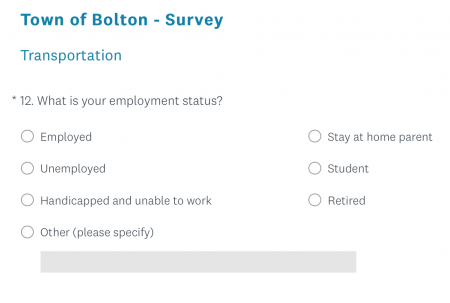Town Resident Survey – Misuse of Section Headers
Let’s move to another example. My town’s planning committee recently conducted a town-wide survey. (Full disclosure: I had been asked by a town employee to help the committee with a related survey. I agreed. Then I was told they didn’t want my assistance. Yes, they turned down free assistance from someone with extensive survey design experience.)
When a Section Header Misleads
The second section of the town survey has “Services” as its header. (See nearby screenshot.) So, the section is about town services, right? The first question in the section (Question 4 overall) asks for the town’s “top three strengths.”

Services Section of Town Resident Survey
As written, it’s a head scratcher. Is this about the three best services delivered by the town? That’s what the header implies. But if you read the question skipping over the header, as many people are likely to do, the question may be interpreted as “the top three reasons for living in Bolton.”
But wait! Just prior, Question 2 asked, “Why do you live in Bolton?” (See nearby screenshot.) Look at the response option checklist. Wanna bet that those are parroted back in the “top three” list for Question 4? Wouldn’t you live in a town (Question 2) due to its strengths (Question4)? They’re essentially the same question.
Of course, only the “Good schools” option is a service. So, whatever the intentions of the survey designer, a serious sequencing issue will color the entries in question 4.

Key Town Attractions – Town Resident Survey
In addition to the question wording, cryptic header, and sequencing issues, soliciting ordered responses as free-form text will be painful to analyze.
A Section Header Bailing out a Poorly Worded Question
Now let’s show how a header can set the stage and lend (some needed) clarity. The next section in the Bolton Town survey was titled “Housing”, and the first question was “Do you have difficulty living in Bolton?” (See nearby screenshot.)

Housing Section of Town Resident Survey
Without the header the question is another head scratcher. What does “difficulty” mean? Even with the header, you have to think about the meaning of the question. I inferred, perhaps incorrectly, that the question is asking about the cost of housing, which may create a “financial difficulty” living in the town.
In other words, is housing prohibitively expensive and are the property taxes a personal budget killer, making it “difficult” to live in Bolton? But nowhere are housing finance or expenses stated.
The header leads the respondent to infer the question is about cost of housing. But using the header for this purpose is a leap of faith.
The question intent was obvious to the question writer, but was it obvious to the question reader? I guarantee this: respondents to this question will have different interpretations of the question. Ambiguity is the killer of survey validity.
Tip: a well-written question leads the respondent to think about their answer, not about what the question means.
Further – and getting away from the role of the header – the question is posed as a binary Yes/No question. Isn’t financial difficulty a scalar concept?
A Section Header That Sets Unmet Expectations
A later section has “Transportation” as its header, but the first question asks about “employment status.” That’s not transportation. The next 3 questions ask about commuting, and they want to analyze those questions in combination with the employment.
But the questions don’t have to be contiguous in order to perform that analysis. The employment question would fit better in the demographics section. Here, it serves to muddy the concept of Transportation.

Opening question in Transportation section of town resident survey
(Aside: the response options aren’t mutually exclusive, and this is a multiple-choice, single-response question type on the web version of the survey. You could be a “Stay at home parent” and be “Employed”. On the hardcopy version of the survey you could check more than one.)
But let’s return to the “Transportation” header. What does that mean? Remember my comment about headers being too cryptic? Here’s another example.
Transportation means more than just commuting. For example, transportation also includes getting to local shopping, especially for seniors who might take a shuttle van. Yet, commuting is the only topic the section covers. So, the header is both cryptic and non-descriptive of the questions posed.






